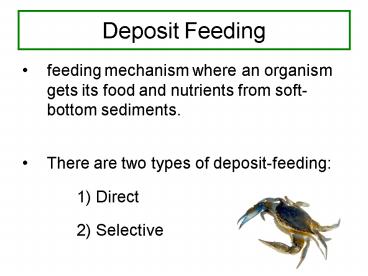Deposit Feeding - PowerPoint PPT Presentation
1 / 15
Title: Deposit Feeding
1
Deposit Feeding
- feeding mechanism where an organism gets its food
and nutrients from soft-bottom sediments. - There are two types of deposit-feeding
- 1) Direct
- 2) Selective
2
What Types of Invertebrates Use This Type of
Feeding Mechanism?
Fiddler Crabs
Sea Cucumber
Earthworms
http//www.fiddlercrab.info/
3
- What are some advantages and disadvantages of
deposit feeding?
- What types of environments are ideal for
invertebrates that use this feeding mechanism?
4
Chemoautotrophy
- - When prokaryotes live symbiotically in the
tissues of invertebrates (usually marine)
- Use CO2 and their carbon source
- Obtain energy by oxidizing H2S NH3, CH4 and
Fe2.
5
Advantages and Disadvantages
Advantages - Inverts have the bacteria produce
all the energy for them - In symbiotic
relationships, neither organism is harmed
Disadvantages - Must live in a place where
these sulfides are in abundance (hot water vents
and deep sea floors) - Must use reduced forms of
the compounds needed
6
Invertebrates that use Chemoautotrophy
- Some Mussels and Clams
- Vestimentiferan Tubeworms
7
Predation
- What is It?
8
- The active capture of live animals
- Involves the finding of prey, pursuit, capture,
handling, and ingestion - 4 kinds stalkers, lurking predators (ambushers),
sessile opportunists, and grazers
9
Scavenging
- What is it?
10
- Moving across the bottom and picking up food
- Includes predatory grazers
- Example would be snails crawling along and
nipping off polyps as they go
11
Two Examples
- Octopuses
- Trilobites
12
Octopuses
13
What Octupuses Eat
- Crustaceans (mostly crabs)
- Some bivalves
14
How They Catch Their Prey
- Speculative pounce and groping methods
- They explore the surfaces of rocks, clumps of
algae and/or the seabed - Usually involves manipulation of the prey
- They will camouflage themselves with their
surroundings, wait for the unsuspecting critter
to go by, and then pounce on it
15
How They Eat Their Prey
- Drill a hole- occurs by the combined action of
the radula and salivary papilla - Salivary glands produce chemicals and enzymes to
weaken shell - Once the hole is completed, octopus injects a
paralyzing toxic agent that induces muscle
relaxation of the prey - When the prey is paralyzed, the octopus ingests
it - When eating bivalves, they drill the hole and
inject the toxin, and after the critter is
paralyzed, they pull the valves apart and ingest
it































